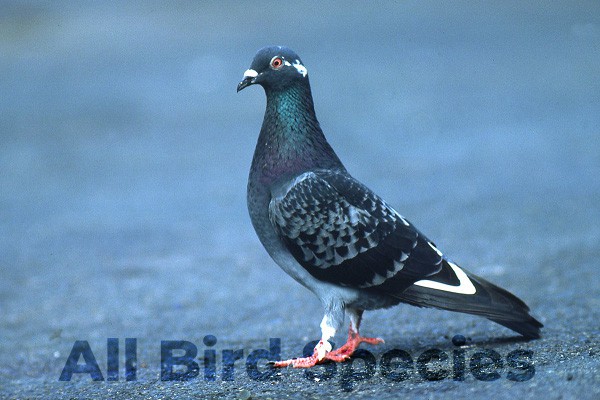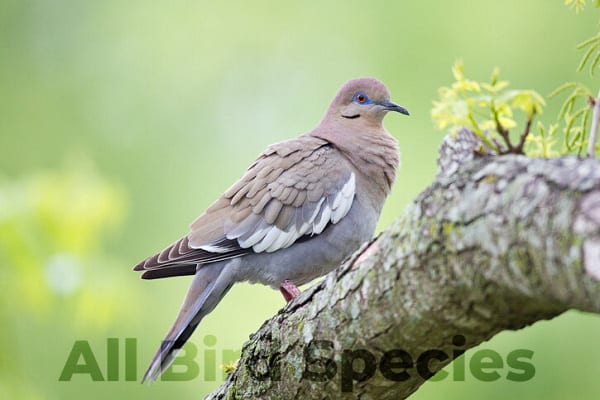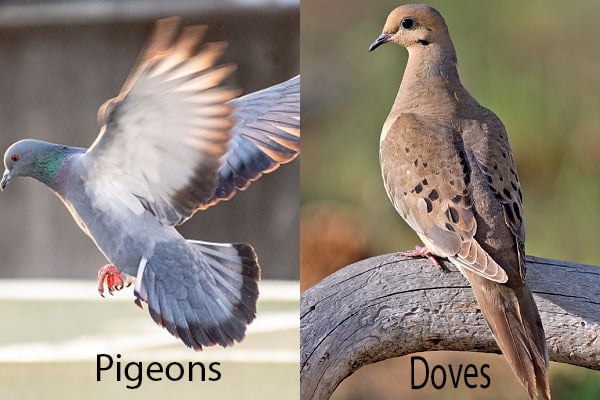4 Types Of Doves in Arkansas (With Photos)
Are you fascinated by doves in Arkansas? Join us as we explore the diverse and beautiful species of these birds in this article. You’ll see captivating images, learn about their characteristics and adaptations, and get tips on how to attract them to your backyard. Whether you’re a seasoned bird watcher or a curious beginner, you’ll find something to interest you in this article. Don’t miss this chance to discover the wonders of doves in Arkansas!
Key Takeaways:
- Arkansas is a paradise for bird enthusiasts, offering a wide variety of dove species.
- Our curated collection of images will transport you into the captivating world of 4 doves. doves in Arkansas.
- Learn about the characteristics, nesting habits, and behaviors of different dove species in Arkansas.
- Discover tips on how to attract doves to your backyard and create a welcoming environment for these magnificent birds.
- Gain insights into dove hunting regulations, bag limits, and the hunting season in Arkansas.
Mourning Dove – A Common Sight in Arkansas

When it comes to sighting birds in Arkansas, the mourning dove is a common and familiar species that captures the attention of bird enthusiasts. With its distinctive appearance and unique behaviors, the mourning dove has become a beloved symbol of wildlife in the state.
The mourning dove, scientifically known as Zenaida macroura, is a medium-sized bird that is recognized for its soft, mournful cooing sounds that can be heard throughout Arkansas. It is easily identifiable by its grayish-brown plumage, pointed tail, and slender build.
This species of dove is often seen perched on telephone wires or foraging for food on the ground, making it a frequent sight in both urban and rural areas of Arkansas. Its flight pattern is characterized by quick, darting movements and distinctive whistling wingbeats, adding to its charm and allure.
Mourning doves are known for their gentle nature and peaceful demeanor, often seen in pairs or small groups. They are primarily seed-eaters, feeding on a variety of grains, grasses, and wildflowers. As ground feeders, they play a vital role in the ecosystem by controlling weed populations and dispersing seeds.
“The gentle cooing of mourning doves is a common sound that echoes across the Arkansas landscape,” says bird expert Jane Peterson. “Their presence brings a sense of tranquility and serves as a reminder of the natural beauty that surrounds us.”
Interesting Facts about Mourning Doves in Arkansas:
- Mourning doves are known for their unique courtship displays, where they perform an aerial acrobatics show, flying in synchronized patterns.
- The distinctive cooing sound of mourning doves is produced by the males to attract females and establish territories.
- This species is migratory, with many individuals traveling to Arkansas during the spring and summer months to breed and raise their young.
- Mourning doves have a short lifespan, typically ranging from 1 to 2 years, but some individuals have been known to live up to 5 years.
Whether you’re an avid bird watcher or simply enjoy the beauty of nature, keep an eye out for the mourning dove on your next outdoor adventure in Arkansas. Their presence is a testament to the rich biodiversity and natural wonders that can be found in the state.
| Mourning Dove | Characteristics |
|---|---|
| Scientific Name | Zenaida macroura |
| Size | Approximately 9-13 inches in length |
| Coloration among different types
of doves can vary significantly | Grayish-brown plumage with a pinkish tinge on the chest |
| Habitat | Wide range of habitats including forests, open fields |
| Diet | Primarily seeds, grains, and grasses |
Rock Pigeon, also known as a rock dove, is commonly seen in cities and backyards in Arkansas. – A Familiar type of doves in cities and backyards in Arkansas Bird in Arkansas

The Rock Pigeon is a familiar bird in Arkansas, commonly seen in urban areas, parks, and even on city streets. Known for its distinctive appearance and cooing sounds, this species, often referred to as a rock dove, is a beloved and recognizable sight for residents and visitors alike.
With their distinct coloring and behavior, Rock Pigeons, a type of dove, have become an integral part of the Arkansas landscape, including cities and backyards in Arkansas. Their plumage varies in shades of gray, with a vibrant iridescence that catches the eye. The familiar “coo-coo” sound of their call echoes through the air, creating a soothing ambiance in bustling cityscapes.
Rock Pigeons are adaptors and have successfully inhabited various environments. Originally native to Europe, North Africa, and Asia, they were introduced to North America hundreds of years ago. Since then, they have thrived in urban areas, finding niches in cities and towns, where they have access to food sources and nesting sites. This adaptability has allowed the Rock Pigeon to become a mainstay in the Arkansas bird community.
The Rock Pigeon’s presence is so ingrained in Arkansas that it has become synonymous with the state’s scenery. From Little Rock to Fayetteville, these birds can be found perched on buildings, foraging for food in public squares, and socializing in flocks. Their ability to adapt to the built environment has made them a common sight throughout the region.
Rock Pigeons have also played a cultural role in Arkansas. They have been featured in various art forms, including paintings and sculptures, demonstrating their significance in local artistic expression. Additionally, their symbolism as messengers and symbols of peace has made them a cherished part of Arkansas’s cultural heritage.
Distinguishing Characteristics of Rock Pigeons:
- Their gray plumage, often with a metallic sheen
- Distinctive cooing call
- Small, sturdy build with a rounded body
- White wing bars visible in flight
If you find yourself in Arkansas, make sure to keep an eye out for these beautiful and familiar birds. Whether you’re walking through the city or exploring a local park, the Rock Pigeon is sure to capture your attention and leave you with a greater appreciation for the diverse bird species that call Arkansas home.
Eurasian Collared-Dove – Thriving, particularly the Eurasian collared dove, which has shown remarkable adaptability in Arkansas.

The Eurasian Collared-Dove, with its distinctive features and remarkable adaptability, has become a thriving species in the state of Arkansas. Originally native to Europe and Asia, the Eurasian collared dove first made its appearance in the Bahamas in the 1970s before spreading to Arkansas. Since then, it has rapidly expanded its range, establishing a strong presence in various regions, including Arkansas.
Known for its striking appearance, the Eurasian Collared-Dove boasts a beautiful plumage, characterized by a soft gray color, with a unique crescent-shaped black collar on its neck. This elegant bird stands out amidst its feathered counterparts, making it a favorite sighting for bird watchers and nature enthusiasts in Arkansas.
“The Eurasian Collared-Dove is a testament to the adaptability and resilience of wildlife in our changing environment,” says John Peterson, an avid birdwatcher from Little Rock. “It’s fascinating to witness how this species has not only survived but thrived in Arkansas, establishing itself as a prominent part of our local ecosystem.”
One of the reasons for the success of the Eurasian Collared-Dove in Arkansas is its ability to rapidly reproduce and colonize new territories. With a short breeding cycle and high productivity, these doves can quickly populate an area and expand their range. This adaptability has allowed the Eurasian Collared-Dove to thrive in urban and suburban environments, making it a familiar sight not only in rural landscapes but also in backyards and city parks across Arkansas.
Comparison of Dove Species in Arkansas
| Dove Species | Adaptability | Range | Distinct Characteristics |
|---|---|---|---|
| Eurasian Collared-Dove | High | Expanded throughout the state | The distinctive black collar
on the neck |
| Mourning Dove | Moderate | Widespread | Long, tapered tail feathers |
| Rock Pigeon | High | Urban and suburban areas | Gray plumage with iridescent
neck feathers |
| White-Winged Dove | Moderate | Localized in southern regions | White wing patches |
The success of the Eurasian Collared-Dove in Arkansas, as highlighted by the Arkansas Democrat-Gazette, underlines the importance of adaptability and resilience in changing environments. As this dove species continues to flourish, it adds to the rich diversity of bird species found in the state, providing bird enthusiasts and nature lovers with captivating sightings and opportunities to appreciate the wonders of nature.
White-Winged Dove – A Unique Species in Arkansas

Among the various species of doves residing in Arkansas, the white-winged dove stands out as a truly unique and captivating bird. Recognizable by its distinct white wing patches, this species brings a touch of elegance to the state’s avian population.
The white-winged dove, scientifically known as Zenaida asiatica, a species also noted by the Arkansas Democrat-Gazette as thriving in the region., is slightly larger than its counterparts, measuring about 11 inches in length. Its plumage features a soft, grayish-brown color on the body with a contrasting white belly. The most striking characteristic of this species is the prominent white wing patches, which are visible during flight and add a beautiful touch to its appearance.
“The white-winged dove’s presence in Arkansas is a testament to the state’s diverse avifauna. Their unique markings and distinctive call make them a delight to spot and observe.” – Bird Enthusiast
While these doves are primarily known for their beauty, they also possess an intriguing behavior. White-winged doves are social birds that often gather in large flocks. Their monotonous cooing call resonates through the Arkansas skies, adding a soothing melody to nature’s symphony.
White-winged doves are native to the southern regions of the United States, including Arkansas. They inhabit a variety of habitats such as woodlands, scrublands, and residential areas. Their adaptability to diverse environments allows them to thrive and become a significant part of Arkansas’ avian ecosystem.
The White-Winged Dove’s Unique Behaviors
- They are known for their distinct cooing call, which is often described as a soft and mournful song.
- These doves are skilled fliers, capable of swift and agile movements in the air.
- The females build their nests in trees or shrubs, creating a secure environment for their eggs.
- White-winged doves primarily feed on seeds, fruits, and grains, making them an important part of the ecosystem’s seed dispersal process and a cherished game bird.
As more bird enthusiasts discover the wonders of Arkansas’ avian population, the white-winged dove continues to captivate with its unique characteristics and presence. Its beauty and distinct behaviors make it a sought-after sighting for birdwatchers, adding to the allure of exploring Arkansas’ diverse wildlife.
Doves and Pigeons in Arkansas – A Variety of Species

Arkansas is home to a diverse range of doves and pigeons, making it an ideal destination for bird enthusiasts. With their unique characteristics and behaviors, these birds offer a fascinating glimpse into the avian world. From the familiar mourning doves to the thriving Eurasian collared-doves, Arkansas provides habitats for several species.
The following table showcases the variety of doves and pigeons found in Arkansas:
| Species | Common Name | Status |
|---|---|---|
| Zenaida macroura | Mourning Dove | Common |
| Columba livia | Rock Pigeon | Familiar |
| Streptopelia decaocto | Eurasian Collared-Dove | Thriving |
| Zenaida asiatica | White-Winged Dove | Unique |
The presents a visual representation of the variety of species in Arkansas, offering bird enthusiasts a glimpse into the rich avian diversity. Each species brings its own charm and characteristics, contributing to the natural beauty of the state.
Whether you are an experienced birder or a curious observer, Arkansas provides ample opportunities to witness these magnificent birds up close. Keep your binoculars ready and explore the diverse habitats to catch a glimpse of these doves and pigeons in their natural environment, where doves may face various challenges but continue to thrive.
Nesting and Behaviors of Doves in Arkansas
Doves in Arkansas exhibit fascinating nesting habits and behaviors that highlight their adaptability and resilience in the region. Understanding these aspects can provide valuable insights into their reproduction and daily activities.
Nesting Habits
Doves in Arkansas typically build their nests in trees, shrubs, or on elevated structures such as power lines, rooftops, and ledges. They use twigs, grass stems, and leaves to construct loosely formed platforms for their eggs. The nests are often flimsy and open, offering little protection from predators and the elements. However, this design allows for easy access and visibility, which may help deter potential threats.
Reproductive Behaviors
Doves breed throughout the year, with peak activity observed during the spring and summer months. Males engage in elaborate courtship displays, including cooing calls, puffing up their chests, and bowing to attract females. Once courtship is established, they engage in a ritual called “billing,” where the male and female gently touch bills as a sign of bonding.
Females typically lay one or two eggs per nesting attempt, which both parents take turns incubating for around 14-16 days. After hatching, the parents continue to divide the responsibilities of feeding and protecting the nestlings until they fledge, which usually occurs within 12-14 days.
Foraging and Social Behaviors
Doves in Arkansas primarily feed on seeds, grains, fruits, and occasionally insects. They have adapted to human presence and can often be seen foraging in open areas, including agricultural fields, lawns, and backyard feeders. They tend to flock together and are known for their cooing calls, which serve as a means of communication and social bonding.
Summary
The nesting habits and behaviors of doves in Arkansas showcase their resourcefulness and ability to thrive in various environments. Their seasonal breeding patterns, courtship rituals, nest-building techniques, and social interactions contribute to their success as a species in the region.
| Nesting Habits | Reproductive Behaviors | Foraging and Social Behaviors |
|---|---|---|
| Build nests in trees, shrubs, and
elevated structures | Courtship displays, egg-laying,
and parental care | Foraging for seeds, fruits,
grains, and social bonding |
| Loosely formed nests for easy access and visibility,
a characteristic noted in the Eurasian collared dove’s adaptation to live in Arkansas. | Male-female bonding through
“billing” ritual | Flock behavior and cooing
calls for communication |
| Vulnerable nests with little protection where
young leave the nest. | Incubation period of 14-16 days | Adaptability to human presence
and open areas is a hallmark of Eurasian collared dove’s success in living in Arkansas. |
Attracting Doves to Your Backyard in Arkansas
If you’re a bird enthusiast in Arkansas, you’ll be delighted to know that attracting doves to your backyard is easier than you think. Creating an inviting environment for these beautiful creatures can be a rewarding experience for both you and the doves. To get started, here are some tips and recommendations:
Create a Welcoming Habitat
One of the first steps in attracting doves is to provide them with a suitable habitat. Doves prefer open spaces with access to perches and abundant food sources.
“Doves are more likely to visit yards that resemble their natural habitat.”
You can create a welcoming habitat by:
- Planting native vegetation, such as sunflowers, millet, and corn, to provide a natural food source.
- Adding bird feeders and watering stations to attract doves.
- Providing perches, such as tree branches or fence posts, for the doves to rest and observe their surroundings.
Choosing the Right Bird Feeders
When it comes to choosing bird feeders for doves, opt for platform or tray feeders. These types of feeders accommodate doves’ preference for ground feeding and make it easier for them to access food.
Fill the feeders with dove-friendly seeds, such as millet, cracked corn, and sunflower seeds. Doves, especially the Eurasian collared dove, are particularly fond of millet, so make sure to include it in the feeder mix for those living in Arkansas.
Watering Stations for Doves
Doves need access to fresh water for drinking and bathing. Providing a shallow bird bath or a shallow container filled with water will entice doves to visit your backyard.
Remember to regularly clean and refill the water to ensure its cleanliness and freshness.
Patience and Observation
Attracting doves To attract doves like the Eurasian collared to your backyard in Arkansas may take some time and patience. Remember, building trust with these birds is a gradual process. Spend time observing their behaviors and preferences to better understand how to create the ideal environment for them.
“By observing doves, you’ll gain valuable insights into their preferences and behaviors.”
Once the doves start visiting your backyard, be consistent with food and water offerings to encourage their return.
| Attracting Doves to Your Backyard Checklist |
|---|
| Plant native vegetation |
| Add bird feeders and watering stations |
| Provide perches for resting |
| Use a platform or tray feeders |
| Include dove-friendly seeds |
| Offer a shallow bird bath |
| Regularly clean and refill water sources |
| Observe doves’ behaviors and preferences |
| Be consistent with food and water offerings |
Hunting Doves in Arkansas
If you’re an avid hunter or enjoy the thrill of outdoor sports, Arkansas offers a prime location for hunting doves. With its diverse landscapes and abundant dove population, the state attracts numerous hunting enthusiasts each year. Whether you’re a seasoned hunter or a beginner looking to try out dove hunting, Arkansas has plenty to offer.
Regulations and Bag Limits
Before heading out for your dove hunting adventure, it’s important to familiarize yourself with the regulations and bag limits set by the Arkansas Game and Fish Commission. These rules are in place to ensure sustainable hunting practices and protect the dove population. Here are a few key regulations you need to know for dove season in Arkansas:
- Hunting license: You must have a valid Arkansas hunting license to participate in dove hunting during the designated dove season. Be sure to check the specific requirements and fees for residents and non-residents.
- Hunting season: The dove hunting season in Arkansas typically runs from September to November. However, it’s crucial to check the updated dove season dates each year in Arkansas, as they can vary.
- Bag limits: The bag limit for mourning doves in Arkansas is 15 per day, with an additional 15 possession limit. It’s essential to stay within these limits to ensure responsible hunting practices.
- Hunting hours: Dove hunting in Arkansas usually begins at noon and continues until sunset. Make sure to plan your hunting trips accordingly.
Tips for a Successful Hunt
Hunting doves requires skill, patience, and a good understanding of dove behavior for successful dove hunters. Here are a few tips to help you have a successful hunt during the dove season in Arkansas:
- Scouting: Before your hunting trip, scout the area to identify dove hotspots. Look for dove roosting areas, feeding grounds, and watering sources. This will increase your chances of finding active dove populations.
- Decoy setup: Set up decoys strategically in an open, visible location to attract passing doves. Use both mourning dove decoys and spinning-wing decoys for added effectiveness.
- Camo attire: Wear camouflage clothing to blend in with the surroundings and avoid alarming the doves. Avoid bright or colorful clothing that may scare them away.
- Shotgun selection: Choose a shotgun with appropriate choke and shell size for dove hunting. Popular choices include 20-gauge and 12-gauge shotguns with improved cylinder or modified chokes.
- Practice shooting: Improve your shooting skills by practicing target shooting before the hunting season. This will enhance your accuracy and increase the likelihood of a successful hunt.
By following these tips and adhering to the regulations, you can have a rewarding dove hunting experience in the beautiful state of Arkansas. Remember to prioritize safety, respect the environment, and enjoy the thrill of hunting in one of the country’s prime dove hunting destinations.
Frequently Asked Questions
Q1: What state has the most doves?
Texas is known for having the highest population of doves in the United States.
Q2: Are pigeons invasive to Arkansas?
Yes, pigeons are considered invasive in Arkansas and can cause damage to property and crops.
Q3: What is the limit on doves in Arkansas?
The daily bag limit for mourning doves in Arkansas is typically 15 birds per day during the regular season.
Q4: How many types of birds are in Arkansas?
Arkansas is home to over 400 species of birds, making it a diverse birdwatching destination.
Q5: Where do doves live in the US?
Doves are found throughout the United States, with different species preferring various habitats including urban areas, farmlands, and open woodlands.
Q6: Do doves live in America?
Yes, doves are native to North and South America, with various species inhabiting different regions across the continents.







